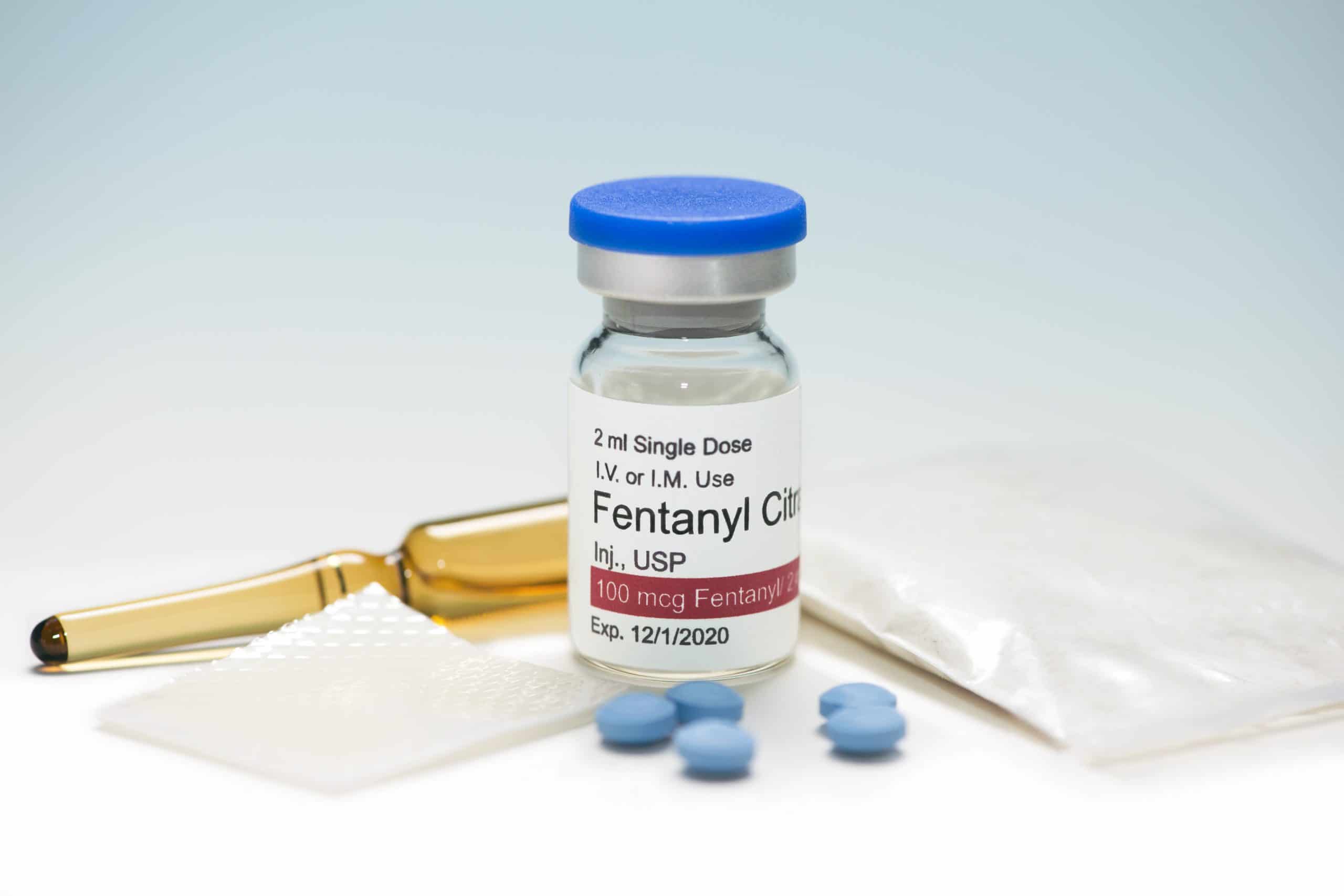Fentanyl drug overdose rates are at an all-time high across the country but more so in Arizona. Arizona is fighting a war on “Mexican Blue Oxy” Oxycodone laced with fentanyl. While the government is looking for ways to stop the flow of the drug into their state, families are seeking ways to help their loved ones before the horrible drug destroys them.
What is Fentanyl?
Fentanyl is a synthetic schedule 2 narcotic analgesic that is 50 to 100 times stronger than morphine and 30 to 50 times more potent than heroin. Fentanyl works by blocking pain receptors in the brain and increases the production of dopamine, which increases the feelings of happiness, relaxation and decreases the perception of suffering. Fentanyl is prescribed for severe pain, after surgery and for chronic pain patients who are no longer finding relief with other opioids. In 2017, In 2017, Arizona providers wrote 61.2 opioid prescriptions for every 100 people.
- Fentanyl is an extremely strong synthetic opioid that is very effective at relieving moderate-to-severe chronic pain.
- Oral versions of fentanyl contain an amount of the drug that can be fatal to a child.
- The difference between a therapeutic dose and a deadly dose of fentanyl is minimal.
- There are many illegal analogs and derivatives of fentanyl that are much stronger than the legal prescription version.
- Recreational users often use fentanyl as a substitute for heroin.
Fentanyl Addiction: Why is Fentanyl so Addictive?
Many people become addicted to fentanyl very quickly due to its euphoric “high” similar to heroin. Fentanyl enters the bloodstream and immediately crosses the blood-brain barrier, where it quickly binds with opioid receptors. The quicker the binding process, the stronger the feeling of euphoria, which makes fentanyl the most dangerous opioid. Compared to other opioids, it takes a very small amount of fentanyl to produce the same effects,
Fentanyl affects everyone differently. The effects are dependent on an individual’s size, weight, the overall state of health, the amount that is taken, whether fentanyl is taken in combination with other drugs, and whether the person is used to taking opioids.
- Fentanyl’s effects include
- extreme happiness
- drowsiness
- nausea
- confusion
- constipation
- sedation
- problems breathing
- unconsciousness
Fentanyl analogs produced in illegal laboratories can be hundreds of times stronger than street heroin and tend to produce significantly more respiratory depression, making them even more dangerous to users than heroin.
Individuals using heroin or cocaine, or in recovery for a drug use disorder may not know that the potency of street-sold heroin and cocaine can be greatly enhanced by adding fentanyl. Because the potency of such drugs is not known, and they are not told about the addition of fentanyl, any illicit drug use – even a reduced dose – can result in an accidental overdose or death. In many cases, drug dealers are mixing fentanyl with other drugs, like cocaine, heroin, methamphetamine, and MDMA. This is because it takes a very small amount to produce a high with fentanyl, making it a less expensive option.
Fentanyl may be taken orally, smoked, snorted, or injected, and no one method of use is safer than another.
Fentanyl Addiction: The Signs of an Addict
The abuse of and addiction to fentanyl or a synthetic form of fentanyl may be shown by the following signs and symptoms:
Behavioral symptoms:
- Secrecy and deceit
- Withdrawal from loved ones and friends
- Little to no participation in significant activities
Physical symptoms:
- Fatigue and extreme drowsiness
- Shallow breathing
- Low heart rate
- Nausea
- Constipation
- Gastrointestinal distress
Cognitive symptoms:
- Disorientation
- Confusion
- Inability to concentrate and focus
- Impaired decision making
Psychosocial symptoms:
- Euphoria
- Anxiety
- Paranoia
- Severe mood swings
People addicted to fentanyl who stop using it can have extreme withdrawal symptoms that begin as early as a few hours after the drug was last taken. These symptoms include:
- muscle and bone pain
- sleep problems
- diarrhea and vomiting
- cold flashes
- uncontrollable leg movements
- severe cravings
Fentanyl Addiction: The Numbers In Arizona Are Alarming
Since 2013, opioid-involved deaths rose 76 percent in Arizona, with 928 deaths reported in 2017. That is 13.5 deaths per 100,000 persons, compared to the average national rate of 14.6 deaths per 100,000 persons. The greatest increase occurred among deaths involving synthetic opioids, mainly fentanyl which increased from 36 deaths in 2012 to 267 deaths in 2017.
Data from one report showed that in 2018, fentanyl was reported in 18 percent of all fatal and non-fatal reported overdoses in Arizona. Since Governor Doug Ducey’s opioid emergency declaration in 2017, fentanyl is the most commonly reported drug involved in fatal overdoses with 301 deaths since June 2017.
The most recent data about overdoses in Arizona shows that:
- In January 2019, there were 47 reported overdoses involving fentanyl in Arizona. Five of these were fatal.
- In February 2019, there were 36 reported overdoses involving fentanyl in Arizona. Two of these were fatal.
- In March 2019, there were 21 reported overdoses involving fentanyl in Arizona, with three fatalities reported.
- Fentanyl is more commonly reported in overdoses among younger Arizonans. Among teens 15-17, fentanyl was the most commonly reported drug involved in suspected overdoses.
Thirteen out of the total 15 counties in Arizona have recorded fentanyl deaths between mid- 2017 and early 2019. The hardest-hit county, La Paz has recorded 597 deaths in 100,000 people in the same period, while the least affected has 106 deaths in 100,000 people within the same period.
Fentanyl deaths have surpassed those of heroin and have affected all Arizona demographics. Residents say it is the worst kind of drug invasion seen in the last 30 years. For example, according to the DEA in Arizona, in 2017, its agents seized 172 pounds of powdered fentanyl. In 2018, they confiscated a total of 445 pounds, pointing to a 159 percent increase.
In 2017, DEA agents had also confiscated over 95,000 pills of fentanyl-laced pills. This amount increased in 2018 to 379,000, which translates to an almost 300 percent increase. So far, in 2019, 1,138,288 illegally manufactured fentanyl pills have been seized. Such a significant increase in illegally created fentanyl shows that war on fentanyl deaths is far from over
Fentanyl Addiction: What is Arizona doing to combat the Issue
In June 2017, Governor Doug Ducey declared a statewide emergency after data was released on the increased number of opioid overdoses primarily from fentanyl.
On January 25, 2018, Governor Doug Ducey signed the Arizona Opioid Epidemic Act. The Act includes measures to cut down on doctor shopping by making it mandatory for doctors and pharmacies to keep databases up to date. The state has also started placing safe disposal bins for all opioids and other prescriptions. There is a limit on the first fills of 5 days. Research shows that any more than 5 days of continuous use leads to a higher risk of addiction.
Since June 2017, the Arizona Department of Health has trained over 1200 first responders to carry and administer Naloxone and has provided over 5100 new Nexalone kits to law enforcement agencies.
Other measures call for $10 million to be spent treating opioid abusers who are underinsured and ineligible for Medicaid. The Good Samaritan Law protects anyone who is overdosing and anyone who witnesses an overdose from prosecution for seeking help. The governor has also implemented the Angel Initiative. It will help individuals struggling with fentanyl addiction, and other opioid addictions seek treatment without prosecution. Meaning that an addict can walk into any police station, turn in their drugs, and ask for help without the fear of going to jail. It also helps parents who seek treatment place their children into care without the children going into foster care.
Ducey called the package a comprehensive model for other states looking to address what has become a nationwide crisis.
Fentanyl Addiction: Destroying Families in Arizona
As the war on fentanyl and fentanyl addiction continue, the destruction of Arizona families is on the rise. There has been an increase in the number of babies being born with a fentanyl addiction, in 2008 there was 1.8 in 1000 hospital births up in 2019 to over 10 cases in every 1000 hospital births. And babies born with a fentanyl addiction suffer lifelong issues. Opioid use during pregnancy has also been associated with developmental delays and intellectual impairment. But most studies were conducted before the use of synthetic fentanyl, and scientists don’t yet know the long-term implications of these substances on babies but are certain that we will see complications that will have devastating effects during their life.
As fentanyl addiction continues to rise, the number of children in homes with family members addicted to fentanyl continues to rise. Witnessing the trauma of a parent suffering fentanyl addiction at a young age has long-term effects on the child. Children growing up seeing a parent addicted to fentanyl are more likely to develop a fentanyl addiction in their teens and adulthood. They are also three times more likely to be neglected, physically, and sexually abused. Since children are still developing their personalities and learn from what they see, they run the risk of repeating such behaviors. Children may be exposed to aggression or violent behavior due to a parent’s fentanyl addiction.
Fentanyl addiction takes over the life of the victim it has claimed. They give up important life activities, such as work, family time, hobbies they once loved. Fentanyl takes over their life; they spend most of their day using fentanyl, looking for fentanyl or finding ways to get money from people to support their fentanyl addiction. Fentanyl becomes such an important part of the addict’s life; they will say and do anything to get the money to support their habit.
If someone you love has a fentanyl addiction, you are likely to experience changes in your thoughts and behaviors. You may find yourself:
- Worrying about your loved one’s drug use
- Losing sleep
- Experiencing constant anxiety
- Lying or making excuses for the addict’s behavior
- Walking on eggshells around the addict
- Withdrawing from your loved one to avoid mood swings and confrontations
- The constant feeling that calling the police when your loved one is high is better than finding them dead
- Putting yourself in dangerous situations to look for or rescue your loved one
- The fear of losing your family member if you talk to them about their drug use
Fentanyl Addiction: How To Get Help
If you have a family member who has a fentanyl addiction, it is a battle of keeping the peace or starting a war of uncertainty. Keeping the peace means not talking to your loved one about their problem, but that comes at the cost of watching them destroy their life. Starting a war of uncertainty means putting it all on the line and giving them no choice.
There is no perfect way to approach someone with a fentanyl addiction to getting help. By the time you get up the courage to fight the battle and talk with your loved one, you already feel defeated by the day to day battle. You are not alone in this war on fentanyl. Families all across Arizona are in this war. Like you, they feel defeated.
Let the caring and compassionate family of Granite Mountain Behavioral HealthCare help you or your loved ones. You contact us here.



